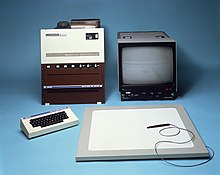Quantel Paintbox
 | |
 Paintbox 7001 and original Paintbox logo from 1990 | |
| Also known as | Quantel Digital Paint Box |
|---|---|
| Developer | Quantel |
| Type | 2D graphics workstation |
| Release date | 1981 |
| Introductory price | $250,000 (1981) |
| Discontinued | 1993 |
| CPU | Motorola 68000 |
| Predecessor | IBC Paintbox prototype |
| Successor | |
| Related articles | Quantel Mirage |
The Quantel Paintbox was a dedicated computer graphics workstation for composition of broadcast television video and graphics. Produced by the British production equipment manufacturer Quantel (which, via a series of mergers, is now part of Grass Valley), its design emphasized the studio workflow efficiency required for live news production. At a price of about $250,000 per unit (equivalent to $374,000 in 2020), they were used primarily by large TV networks such as NBC,[1] while in the UK, Peter Claridge's company CAL Videographics was the first commercial company to purchase one. Following its initial launch in 1981, the Paintbox revolutionised the production of television graphics.
Original line[]

The first generation Paintbox, the 1981 DP-7001, was principally custom-designed hardware, while the second generation V-Series introduced in 1989 was able to take advantage of general purpose computer hardware combined with custom hardware elements.
Paintbox DPB 7000/7001[]
Artist worked with Quantel's development team to develop the artist-oriented functionality and user interface, which remained virtually unchanged throughout the life of the product; the custom developed pressure-sensitive pen which proved the killer app.[2]
Paintbox V-series[]
| Paintbox V-series promotional video | |
|---|---|
Released in 1989 modernized and more compact model;[3] aside from internal hardware improvements, the new keyboard and cordless pen also introduced.
In the late 1980s, Quantel embarked on lawsuits against the Adobe Photoshop software package and the Matisse system in an attempt to protect patented aspects of the Paintbox system. They won the initial case against Spaceward in 1990, but finally lost the case against Adobe in 1997 following depositions and demonstrations by a number of Computer Graphics pioneers including Alvy Ray Smith and . Richard Shoup ported his 1973 paint program SuperPaint to Windows for demonstration purposes, and was able to demonstrate that Superpaint had particular features before Quantel's Paintbox. Shoup's port is available for download from his personal website.[4]
From the end of lifespan of Paintbox V line most of his features was also integrated into the latest ,[2] and in 1993 the were merged the both lines.
Demise of Quantel[]
Despite becoming the industry standard TV graphics and post production computer with hundreds sold around the world, Quantel lost all its market share against cheaper systems and software. There is only one known DPB- 7001 still exists and is currently being restored and repaired by Mark Nias on the 40th anniversary of its launch.
Notable works[]

The cover for The Miracle, rock band Queen's studio album, was created by Richard Gray on a Quantel Paintbox in 1989. It was used by six artists and designers, including David Hockney and Richard Hamilton, to create original artwork in the 1987 BBC series . Quantel also placed a number of Paintbox IV series systems in art schools in the UK, including Blackpool College where it was used extensively by artist Adrian Wilson to create digital images, including the James album cover for Gold Mother. Two of Wilson's Paintbox pieces were included in the pioneering Art & Computers exhibition at the Cleveland Art Gallery, England, September 1988 and he was sponsored by Quantel, who used his images for the cover of the Graphic Paintbox sales brochure. One recipient, Duncan of Jordanstone College of Art had recently appointed the video artist Stephen Partridge as a lecturer who then established (1984) The Television Workshop to support artists and filmmakers' production and access to high-level broadcast technology. Over 400 productions were supported in this way from 1984 to 1992 until desktop video pre-empted the need. Artists and filmmakers using the workshop included Richard Morrison,[5] , Robert Cahen, Tamara Krikorian, Pictorial Heroes, Judith Goddard and many others.[6] The music video for Dire Straits' "Money for Nothing" was created on a 3D animation system using a Quantel Paintbox for backgrounds and textures.
Reintroduced model[]
This section needs expansion. You can help by . (July 2021) |
In 2002, the generationQ series of products introduced the last stand-alone Paintbox and the QPaintbox software for PCs.[7] Eventually, Paintbox became a feature of Quantel's other, more powerful editing, media management and post-production products.[8]
In 2005 Quantel update the line of X86-based workstations (with Paintbox and Paintbox gQ models, and QPaintbox software-only version).[9][10] The new Quantel Editbox also released.
See also[]
| Wikimedia Commons has media related to Quantel Paintbox. |
- Video Toaster, later (1990) system
References[]
- ^ Ward, Alex (1984-07-22). "COMPUTER GRAPHICS ENLIVEN THE SCREEN". The New York Times. ISSN 0362-4331. Retrieved 2017-07-08.
- ^ a b Pennington2019-11-25T23:09:00+00:00, Adrian. "Industry innovators: Quantel". IBC. Retrieved 2021-07-01.
- ^ Robertson, Adi (2012-07-14). "Watch this: 1990 demo of the Quantel Paintbox". The Verge. Retrieved 2021-07-01.
- ^ "The SuperPaint System (1973-1979)". Archived from the original on September 1, 2015. Retrieved 2015-09-01.
- ^ Landekic, Writer Lola; Landekic, Interviewer Lola; Perkins, Editors Lola Landekic Will; Published September 15, 2015. "Hackers". www.artofthetitle.com. Retrieved 2021-07-01.CS1 maint: extra text: authors list (link) CS1 maint: numeric names: authors list (link)
- ^ The Television Workshop
- ^ Pank, Bob. "The Digital Fact Book Converged media 20th anniversary edition" (PDF). Retrieved 2009-11-06.
- ^ "Pablo grading and finishing for HD, 2K, 4K and stereo3D" (PDF). Retrieved 2009-11-06.
- ^ "QUANTEL'S NEW GENERATIONPRODUCTS ARE NOW THENUMBER ONE CHOICE WITHBROADCASTERS" (PDF). film-tv-video.de.
- ^ October 2004, TVTechnology 07 (7 October 2004). "Quantel re-engineers Paintbox". TVTechnology. Retrieved 2021-07-01.
External links[]
- Computer workstations
- Film and video technology
- Quantel
- Computer-related introductions in 1981